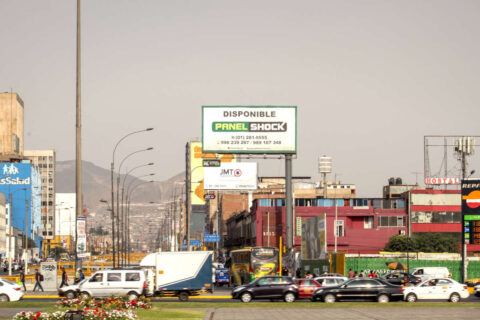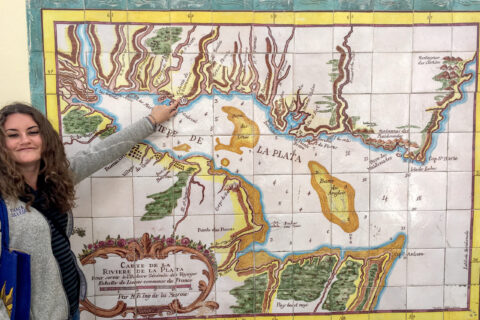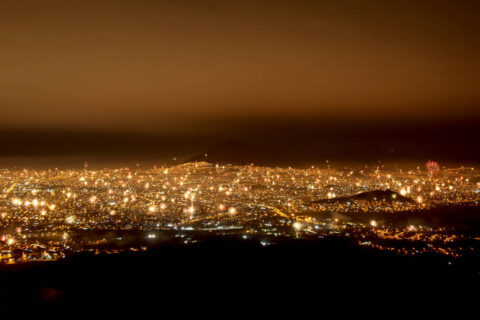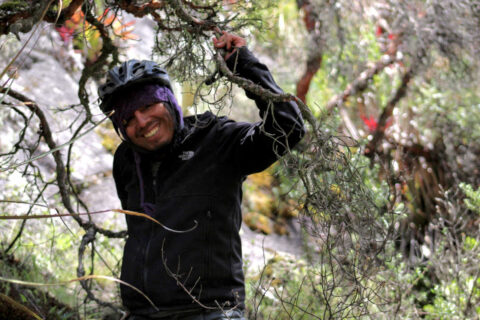AUTHOR
Sierra Vorsheim
HEADER IMAGE
Espaanglisch
DATE
October 16, 2021
I speak with my Dad about the phenomena of returning to the US, after extended periods away, frequently upon my returns from Peru. After months of adventure, seeing things, eating things, experiencing things so unlike anything you would ever experience where you’re from, more often than not, upon your arrival you expect a full fanfare to welcome you back. You arrive to the airport in Atlanta or Miami anticipating a brass band hailing your return, customs agents greeting you with overexcited grins and enthusiasm. “Welcome back!” When you arrive to your hometown, well, of course there will be a massive welcome party, everyone will just want to drop what they’re doing and, immediately, turn all attention to you. Where have you been? What have you been doing? What was it like?
The reality is, undeniably, a different picture, though I can’t say that I’m entirely disappointed with the difference. I suppose it would be creepy and disconcerting to see a customs agent greeting you with a maniacal grin on their face after you’ve been on a 6-hour overnight flight, first questioning if you have anything to declare then asking for your purpose of travel and then giving you an overly enthusiastic “WELCOME BACK!” at which point, oh boy… that brass band was there all along! “Hooray,” you think as they leap into booming renditions of Sousa marches in the early morning hours. You were thinking you wouldn’t be in the mood for 6am airport wine but this has you reconsidering the prospect…
I have to say, however, that after being away for a year and a half due to a pandemic, the return, and transition back to life in the United States, while still nothing like the aforementioned scenario, has been different, to say the least.
When the COVID-19 pandemic really took a turn for the worse in March of 2020, forcing the majority of the world’s governments to put into place strict lockdowns, shutting down borders and more, I found myself in Peru. I had been scheduled to leave the country upon the end of yet another tourist visa in early April. The end of my visit was supposed to have involved a trip to the one reason a large majority of travelers make their way to Peru in the first place — Machu Picchu. This trip was to have come, at last, on my fourth long-term trip to the country. It would have also marked the momentous occasion of the first-time visit of my mom and a couple of friends, plus one of their boyfriends, to Peru. Amongst all of my trips to Peru, the majority of which had been for at least three months, I had only been visited by family (my Dad) once prior.
These exciting plans were effectively quashed by the onslaught of this pandemic which would, as we all know, claim millions of lives globally. The rapid shift of circumstances happened, quite literally, overnight. Saturday night, I was out drinking and dancing in packed clubs in Trujillo. On Sunday, news outlets made the announcement — Peru was going into lockdown. By Monday morning, the country was shutdown and millions of travelers found themselves stranded in a panic or, perhaps, strangely enough, an oddly content stupor.
I found myself to be quite firmly placed in the latter, after an initial moment of panic. After months of nonstop social interaction this sudden pause in the everyday flow of life was, in some perverse way, refreshing. Beyond the uncertainty of my visa status, I felt strangely calm and content. Perhaps it was shock or perhaps it was the overwhelming, admittedly selfish, gratefulness that I had for the fact that this gave me the opportunity to, at last, spend more time in a country which I had always desired to spend longer than the maximum 6-month tourist stay. Whatever it was, in the initial stages of the pandemic, I felt fine and hopeful in some way. It was all about making the best of an otherwise potentially bleak situation.
What I can say about the beginning of the pandemic in Peru is that, comparatively speaking, I was impressed by the swift response of Peru’s government to the developing situation, this action being born out of some type of necessity. Whereas it may have seemed unnecessarily strict to some, had it not been for this swift and strict action in the beginning, it would not have surprised me if the effects of the pandemic in Peru were far worse, and Peru has been hit rather hard as it is.
You may be curious as to what this strict action was. Aside from borders being shutdown quite literally overnight, what also came into effect was a shutdown of basically the entire country, save for anything that was considered an essential service (i.e. grocery stores, pharmacies, etc.). Were you not part of these essential services or were you not going to utilize these essential services, you weren’t permitted to leave your home.
To enforce this rule, there were a number of rules that came about and changed rather rapidly, ranging anywhere from the “only one member of a household” rule to gender specific days (this was quickly quashed due to protests of lack of inclusivity) and the no-car rule which resulted in a haven for cycling in Trujillo… of course, when one was going to pick up there groceries and such. The military was deployed in cities across the country and police and security forces enforced these ever-changing rules. The efforts by law enforcement putting themselves on the frontline of a developing pandemic situation were appreciated by many. It was not uncommon for them to be applauded as they drove by neighborhoods at night. In Trujillo, the local government took advantage of the reduced traffic in previously heavily trafficked areas of the city to clean up local marketplaces and make at least some street repairs.
In addition to restrictions on movement and travel, a mask mandate was also quickly put in place. No mask? No market. This was a rule that also evolved over time. In the beginning, makeshift masks were completely acceptable. There was a phase where gloves were also required. Then specific types of masks to enter grocery stores. And then double masking. And then face shields. This all evolved with the ever-changing COVID infection rates, something which was divided and monitored by region, as well as the ever-evolving scientific knowledge of COVID, where the hell it came from, and how the hell it was spread.
Curfews were also a thing once society began to open up again and we weren’t on 24/7 lockdown. These were determined regionally and, sometimes, were even city-specific. They also changed frequently — once every two weeks or more. It got to a point where, quite frankly, it was difficult for everyone to keep track. Worst come to worst, though, you ended up like me and my partner, David, sitting around, blissfully unaware at 9:45pm in the evening, awaiting your pollo a la parilla at a restaurant you frequented around the corner, that the curfew was 9pm. The police soon to inform you that you were supposed to be home 45 minutes ago. That said, you could wait to get your chicken and then get outta there. Gracias, officer!
I handled what could otherwise be a monotonous existence, staying confined within the Espaanglisch Casa for days at a time, by throwing myself into a number of productive pursuits — a reaction which seemed to be quite similar for people around the globe. I threw myself into my online work, took free online marketing courses from HubSpot and Google Analytics, continued with twice weekly conversation classes, finally got this very website up and running. I learned how to properly hand wash my clothes and developed a strange interest in trying out different cleaning fluids for our home, learning which in Peru I liked the best, the favorites being Pride, Peru’s version of Pledge, infused with argan and specifically the blue version of Poett, a multi-use cleaner which can be quite difficult to find in stock at times. For those times when it can’t be found, my backup favorite is now the blue Sapolio.
I also developed an interest in wine tasting and began making a habit of purchasing two wines every week, one red and one white. This may have been inspired by multiple nights where David made batches of Sangria that we sipped and enjoyed while watching movies. This accelerated pursuit of wine tasting didn’t last too long due to budgeting constraints (alcohol is an expensive hobby) but was enjoyable while it lasted.
There was the testing of workout apps for at-home workouts, tons of movie nights, watching all of Star Wars, the Matrix, Avengers movies, Parasite, The Pianist… ALL the movies. There were pancake Sundays and Friday night pizza nights, bread baking (yes, I hopped on that train too), testing new recipes then, eventually, cycling in the countryside, hikes up the local mountains…
With all of these activities there was also an inherent realization, one which had always been there but became even more blatantly obvious during a night of drinking yet another bottle of wine — this realization being that of privilege.
As the pandemic stretched on, we had the desire to continue contributing to the local community in some fashion, even if it wasn’t possible to have a consistent flow of volunteers to Espaanglisch. It was decided that amongst one of the most effective ways to support some of whom were struggling the most in Trujillo was to contribute to the Ollas Comunes.
Ollas Comunes literally translates to “Common Pot”. Within, especially, the poorer areas of Trujillo, groups of neighbors came together to form these “common pots” where, basically, they would all contribute what they did have – perhaps some potatoes from one neighbor, rice from another, chicken, veggies – and then, together, would cook meals which would be distributed amongst everyone within the neighborhood.
Alto Trujillo alone was home to dozens of Ollas Comunes, which could be distinguished by makeshift banners and signs. In the midst of the pandemic, one of the most effective ways to provide aid to areas such as these was to make food donations to these Ollas Comunes. At Espaanglisch, we collected monetary and physical donations and, with the monetary donations, purchased giant sacks of potatoes and rice, oil, pasta – you name it – and then found volunteers to drive pick-up trucks filled with these supplies to select Ollas Comunes where they would then be distributed. My partner, David, helped to spearhead these efforts and made ties with the local community there that continue to this day as Espaanglisch works to find a home for a community center.
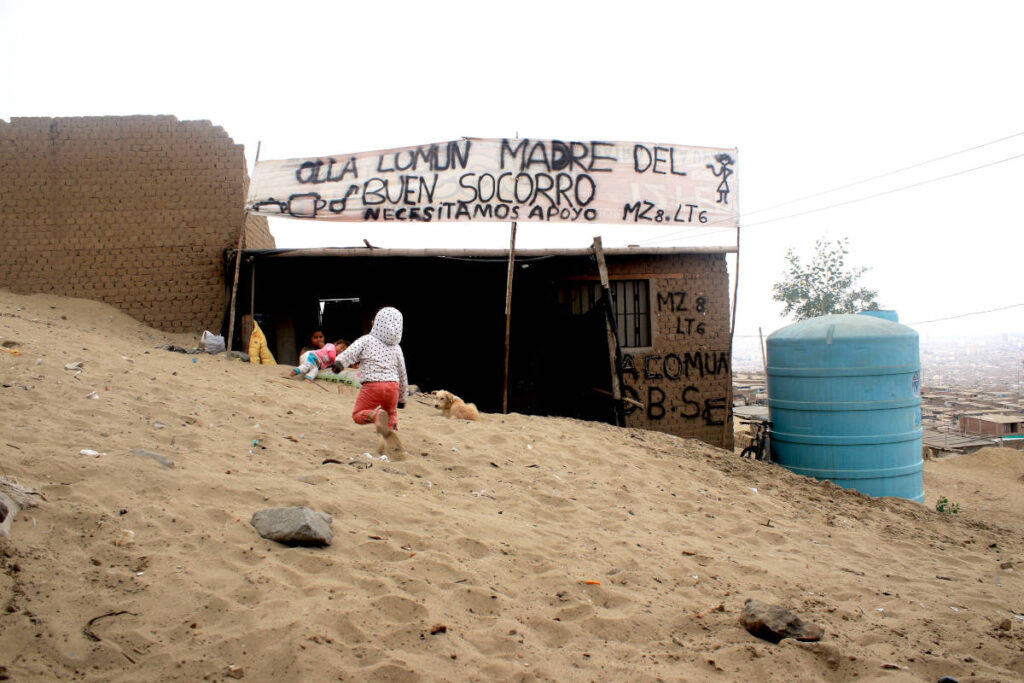
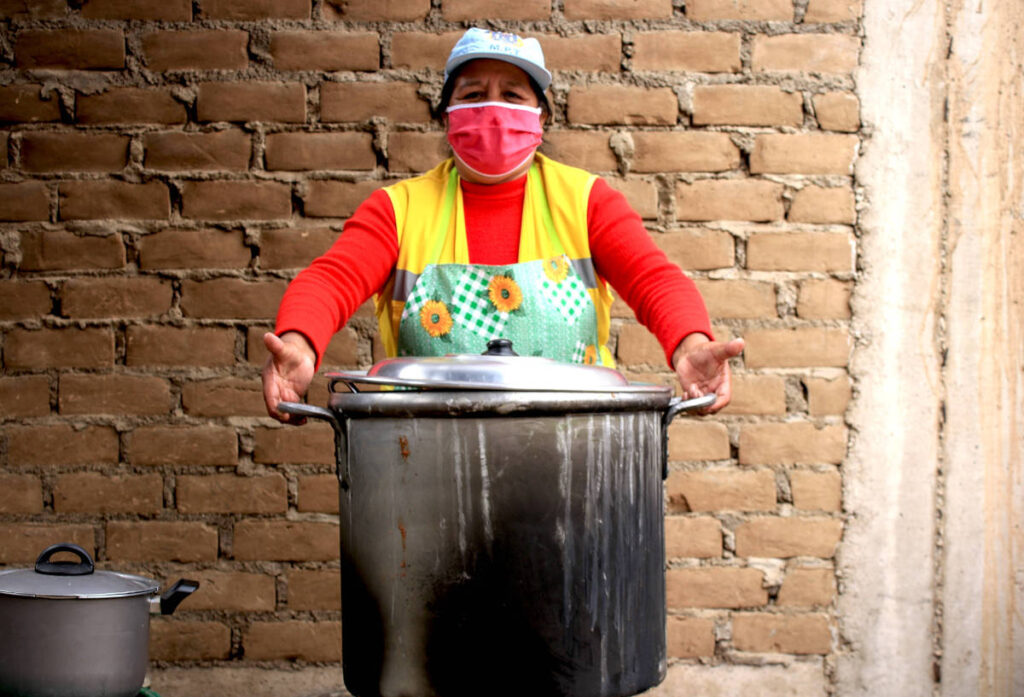
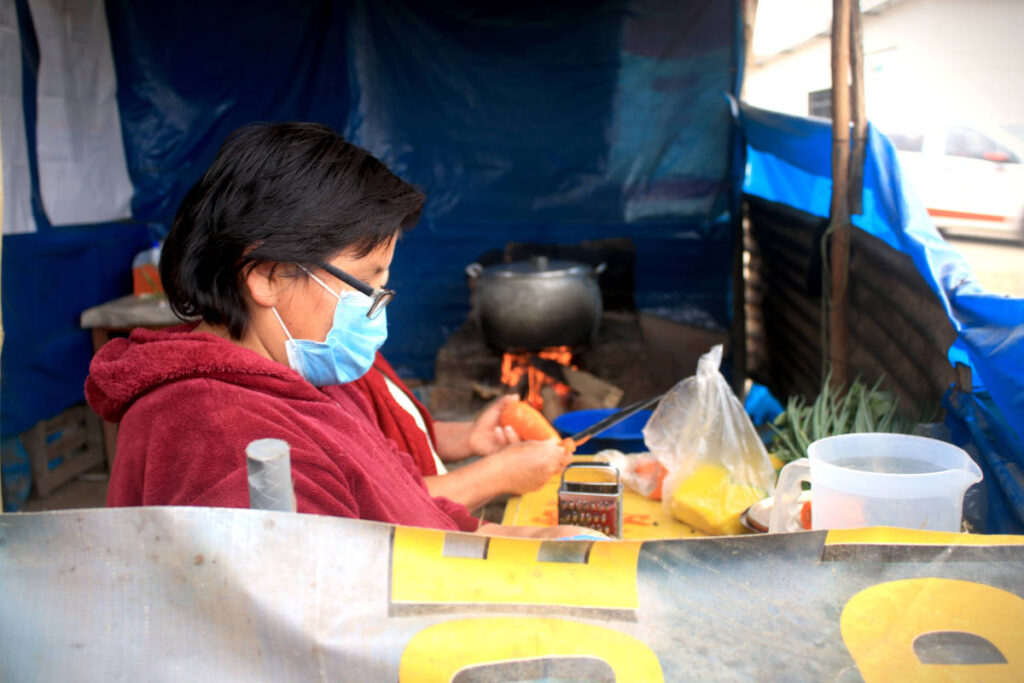
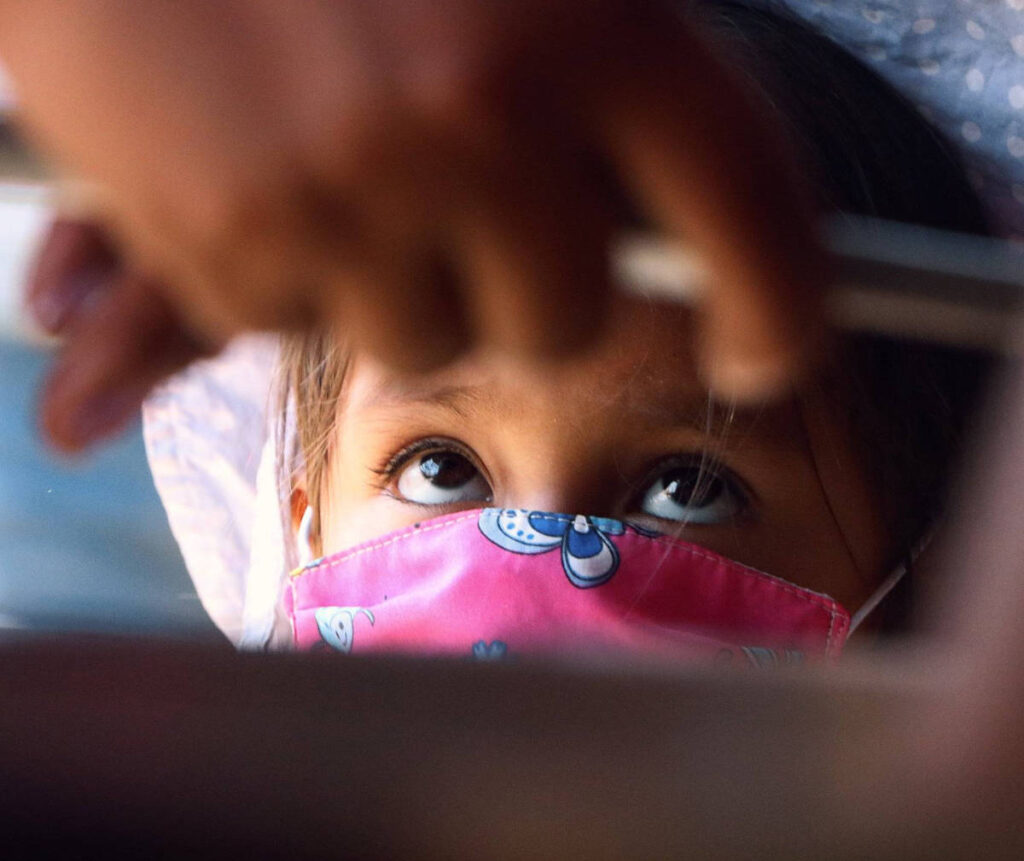 Photos of the Ollas Comunes, contributed by Espaanglisch
Photos of the Ollas Comunes, contributed by Espaanglisch
The Ollas Comunes, in my opinion, are just one of many examples of the ingenuity and adaptability of people and communities within Peru. They were also a testament to an unfortunate reality — for many, remaining strictly quarantined for months on end was, quite literally, impossible.
Within Peru, at least 70% of the economy is informal which translates to a large majority of the population having no benefits from the work that they do and, quite literally, surviving from paycheck to paycheck, day by day on what sales they can make from their economic pursuits. This meant that, for many, not working was simply not an option. Community initiatives, such as the Ollas Comunes, helped to alleviate some of this stress yet, when it came down to it, were simply not enough to prevent what would become a necessity for many to return to work.
It’s for this reason, I imagine, cases in Peru would eventually come to skyrocket despite such swift action to start. Many had to return to work in whatever capacity they could. This even resulted in such changes as many businesses shifting to fit within the “essential business classification” (i.e. from eat-in restaurants to bodegas selling essentials) as well as markets, such as Hermelinda and Mayorista, gradually returning to a level of hustle and bustle that were reminiscent of pre-pandemic times. Delivery apps, such as Rappi & PedidosYa (formerly Glovo) flourished and a number of businesses began to use WhatsApp Business extensively to provide low-contact order and delivery services to customers.
Juxtapose this with someone, such as myself, happily sipping yet another sangria as people were, struggling to concurrently make ends meet and comply with rules regarding social distancing, quarantining, and so forth — the world can be a pretty damn disturbing place sometimes, and COVID only made these disturbing realities that much more obvious.
The spotlight that the pandemic placed on these realities, I think, at least partially contributed to a number of protests and initiatives, as well as a general sense of political unrest, that occurred both in Peru and around the world over the course of the past couple of years. From a scandal regarding COVID vaccinations being distributed amongst top government officials months before the general public would have any type of access to them, causing the resignation of several ministers in Peru, to initiatives amongst Black Lives Matter organizers bringing light to the disproportionate ways in which communities of color have been affected by the pandemic, to protests in Colombia over pandemic related tax reforms that received violent police response. In all of these examples we can see the common link of omnipresent inequality that has only been exacerbated and intensified by a devastating pandemic.
Throughout the duration of the pandemic in Peru, despite times of political unrest, such as the transition of three presidents in one week, and the ongoing stress that the pandemic was placing on the economy and society at large, I found myself cautious and weary; anxious but not afraid. Life continued on. I complied with the rules and regulations and was maybe even overly cautious, avoiding going out too much and seeing people. Despite this abundance of caution, I still managed to contract COVID in March of 2021. The worst part of the whole experience had to have been the understanding, after hearing numerous stories both from acquaintances and on the news regarding hospitals filled to absolute capacity, shortages of oxygen tanks, and so forth, that if things were to go to shit with my illness I very well could have been shit out of luck. Not to mention the fear that, even if I did recover, there was always the possibility that I had passed it on to David or his aunt and it could hit them worse.
Luckily for me, beyond an emotional rollercoaster ride, full loss of my senses of taste and smell (which returned rather quickly, upon recovery), and a brief yet terrifying moment of breathlessness, I rode out my illness quickly and efficiently and everyone within the household remained just fine. Me, there, binge-watching Bridgerton while someone was losing a father or an uncle or a brother or sister. Someone else, struggling to breathe with no hope of getting an oxygen tank anytime soon. Another, struggling to make ends meet. Children, despite it all, still dancing and playing in the streets. Many, despite it all, still managing to maintain their senses of humor. Beacons of light in what could otherwise look to be a cold and grim world.
So, when I returned to the US, I didn’t expect a brass band or smiling Customs officers. I’m not entirely sure, to be honest, what I expected. Perhaps lots of questions, demands for paperwork regarding COVID testing, declarations of being illness free, you name it. And yet, the return was similar as to what it had been like before. Few questions and surprisingly quick. No questions regarding paperwork which I had been so stressed about putting together leading up to the trip. The primary difference being that some people were wearing masks, the key word being “some”. By June of 2021, when I did return to the US, a large number of people had already stopped with the whole mask thing. And I found myself taken aback with surprise. After going through a whirlwind of a year and a half, the effects of which I don’t think I’ll fully understand for years to come, things felt surprisingly unchanged.
Summer was near, cases were dwindling, people were being vaccinated, masks were coming off and many seemed to hold an overwhelming hope that things would soon be back to the way they were before, back to pre-pandemic times. A hope that has not quite been achieved. The question remains, though — do we really want things to go back just to the way they were?
I would never argue with once again living in a pandemic-free world but as to the rest of it? It’s out there, it’s always been there. Hopefully, with this greater clarity and exposure, positive change will come rather than a mere blip of COVID and, then, continuation of what has been for far too long.



